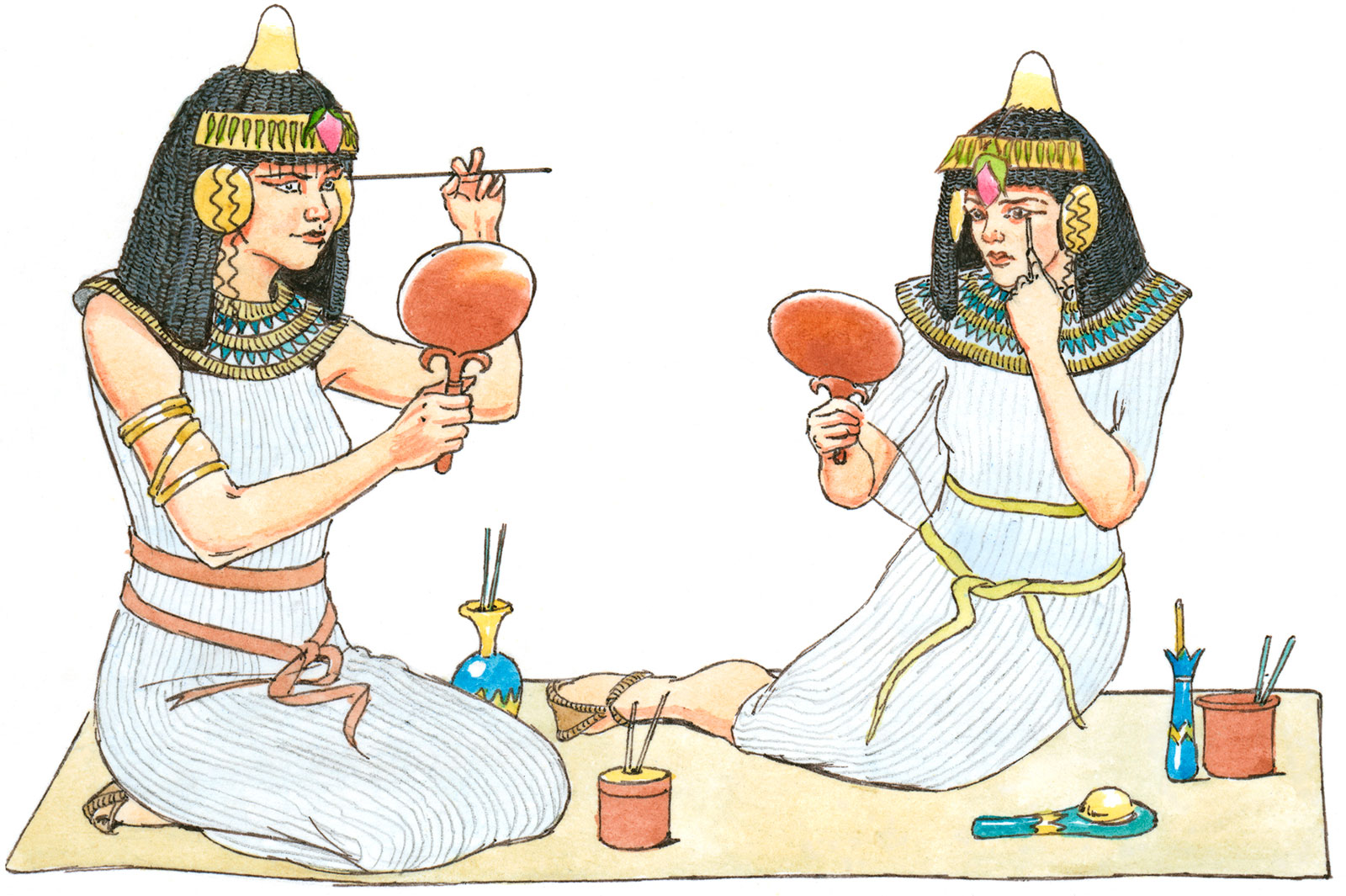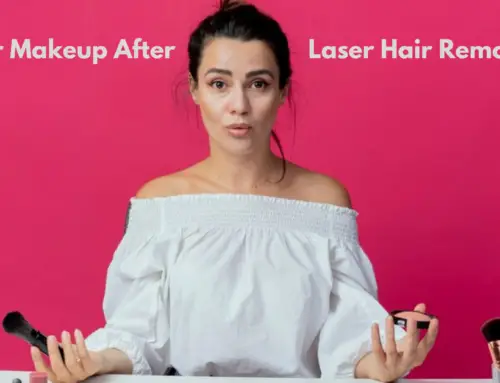In ancient Egypt, makeup was not just for women. Surprisingly, both men and women wore makeup as part of their daily lives.
Makeup was considered an essential part of the ancient Egyptian culture, symbolizing not only beauty but also religious and social significance. From pharaohs to commoners, people of all social classes applied makeup to enhance their appearance and express their status in society.
Ancient Egyptians, both men and women, wore makeup as part of their daily lives. They believed that cosmetics had both practical and spiritual benefits. While both genders used makeup, women were particularly known for their elaborate makeup routines. They used kohl to highlight their eyes, created elaborate eyeshadow designs using powdered minerals, and applied rouge to their cheeks. Makeup was considered a form of beauty enhancement and a way to express one’s social status in ancient Egyptian society.

The Fascinating World of Ancient Egyptian Makeup
Ancient Egypt is known for its rich culture, powerful pharaohs, and impressive monuments. But one aspect that often captures the imagination of people is the ancient Egyptians’ use of makeup. Makeup held great significance in ancient Egyptian society, and its use was widespread among both men and women. Let’s dive into the fascinating world of who wore makeup in ancient Egypt and the reasons behind it.
Royalty and Nobility
In ancient Egypt, makeup was not limited to just the common people; it was also worn by the royal family and the nobility. The pharaohs and queens would use makeup to highlight their status and enhance their beauty. The use of vibrant colors like green and blue was especially popular among the upper class. They had access to the finest cosmetics and dyes, which were often imported from other parts of ancient Egypt or neighboring regions.
In addition to enhancing their appearance, makeup was also believed to have magical and protective properties. The royals and nobility believed that wearing makeup would bring them closer to the gods and ensure their favor, as well as protect them from evil spirits. For these elite individuals, makeup was not just about vanity but also about spirituality and protection.
Priests and Priestesses
In ancient Egypt, priests and priestesses played a vital role in religious ceremonies and rituals. They were considered intermediaries between the gods and the people. It is no surprise then that they too wore makeup as part of their religious duties.
Priests and priestesses used makeup to symbolize their divine connection and to purify themselves before entering sacred spaces. They often wore heavy black kohl eyeliner, which not only accentuated their eyes but also protected them from harmful rays of the sun, believed to carry negative energy. This practice of wearing eyeliner was also thought to mimic the eyes of the falcon god Horus, symbolizing protection and symbolically enabling the wearer to see into the realm of the gods.
Makeup was an integral part of the religious rituals performed by priests and priestesses, and it helped them create a visual representation of their spiritual duties and status.
Entertainers and Prostitutes
Ancient Egyptian society also saw the use of makeup among entertainers and prostitutes. Entertainers, such as dancers, musicians, and acrobats, would wear vibrant and elaborate makeup to enhance their performances and captivate their audience.
Prostitutes, known as “hierodule,” were an accepted part of ancient Egyptian society. They were often associated with the goddess Hathor, who represented love, beauty, and pleasure. These women would use makeup not only to enhance their beauty but also to symbolize their connection to the goddess. Wearing makeup was seen as a way to attract customers and engage in their profession.
Common People
While makeup was more prevalent among the upper classes, it was not limited to them alone. Even common people in ancient Egypt, both men and women, would use makeup in their daily lives. They would use natural ingredients like ground ochre and charcoal to create various shades of cosmetics.
For women, wearing makeup was considered a way to enhance their beauty and attract a potential partner. Men, too, would use makeup, albeit in a subtler manner, to highlight their best features or to imitate the appearance of their idols and deities. It was a way for the common people to express themselves and feel a sense of belonging to the larger society.
Children and Funerary Practices
Interestingly, makeup was not limited to just adults in ancient Egypt. Even children would wear makeup, especially during religious ceremonies, to mimic the appearance of the gods.
Additionally, makeup played a significant role in ancient Egyptian funerary practices. The deceased would be adorned with makeup for their journey into the afterlife. This included eye makeup and red ochre for the lips and cheeks, creating a sense of vitality and ensuring a proper appearance in the afterlife.
The Legacy of Ancient Egyptian Makeup
The use of makeup in ancient Egypt had profound cultural and societal implications. It went beyond mere aesthetics and was intertwined with spirituality, social status, and even religious practices. The legacy of ancient Egyptian makeup can still be felt today in modern beauty rituals and trends.
Modern makeup enthusiasts around the world continue to draw inspiration from the iconic looks of ancient Egyptian men and women. From winged eyeliner to bold lip colors, the influence of ancient Egypt can be seen in the modern beauty industry.
The fascination with the world of ancient Egyptian makeup continues to captivate researchers, historians, and beauty lovers alike. It serves as a testament to the enduring legacy of this ancient civilization and its profound impact on the world of cosmetics.
Conclusion
Who Wore Makeup in Ancient Egypt?
| Group | Reason for Wearing Makeup |
|---|---|
| Royalty and Nobility | Highlight status and enhance beauty, believed to have magical properties |
| Priests and Priestesses | Symbolize divine connections and purify before sacred rituals |
| Entertainers and Prostitutes | Enhance performances and symbolize their trade |
| Common People | Express themselves and enhance beauty |
| Children and Funerary Practices | Mimic appearance of gods and ensure a proper afterlife |
Key Takeaways:
- Ancient Egyptians of all genders and social classes wore makeup.
- Makeup held deep cultural and religious significance in ancient Egypt.
- Both men and women used makeup to enhance their beauty and protect their skin.
- Makeup was also used for medicinal purposes and as a form of protection against evil spirits.
- The use of makeup in ancient Egypt reflected the wealth and social status of the individual.
Frequently Asked Questions
In ancient Egypt, makeup was worn by both men and women, serving various purposes for different social classes. It was a significant part of their daily lives and held cultural, religious, and aesthetic significance. Let’s explore some common questions related to who wore makeup in ancient Egypt.
1. What types of people wore makeup in ancient Egypt?
The use of makeup in ancient Egypt was not limited to a specific gender or social class. Both men and women, regardless of their status, wore makeup on a regular basis. It was a common practice among the elite, middle class, and even laborers. Makeup was considered an essential part of personal grooming and was worn by people of all ages.
For the elite, makeup was an indication of wealth and status. They used a wide range of cosmetics and elaborate techniques to enhance their appearance. On the other hand, middle-class individuals and laborers used simpler makeup products to achieve a polished look. Therefore, it can be said that makeup was prevalent among people from all walks of life in ancient Egypt.
2. What were the reasons for wearing makeup in ancient Egypt?
There were several reasons for wearing makeup in ancient Egypt:
- Cultural Significance: Makeup had cultural significance and was associated with religious rituals, ceremonies, and rites of passage.
- Protection and Health Benefits: Certain makeup products, such as kohl eyeliner, served as protection against the sun’s glare and potential eye infections.
- Aesthetic Purposes: Makeup was used to enhance physical beauty, achieve desired appearances, and highlight specific facial features.
- Symbolism: Makeup was believed to have protective and supernatural powers, warding off evil spirits and bringing good fortune.
Overall, the reasons for wearing makeup in ancient Egypt were multifaceted, encompassing cultural, health, aesthetic, and symbolic aspects.
3. What types of makeup did people in ancient Egypt wear?
Ancient Egyptians used a wide range of makeup products, including:
- Kohl Eyeliner: Black kohl eyeliner made from crushed minerals was the most iconic makeup product and was worn by both men and women.
- Eye Makeup: They also used eyeshadow, such as green malachite or blue copper-based pigments.
- Foundation: A mixture of oils, crushed minerals, and pigments was used as foundation to even out the skin tone.
- Lip Makeup: Red ochre or carmine was used to color the lips, and they often applied balms or glosses for a shiny finish.
- Henna: Henna was used to dye hair, nails, and fingertips.
These are just a few examples of the makeup products that were commonly used in ancient Egypt.
4. Were there any negative connotations associated with wearing makeup in ancient Egypt?
In ancient Egypt, wearing makeup generally had positive connotations. It was seen as a sign of beauty, health, and social status. However, there were a few negative connotations associated with excessive makeup usage.
Excessive makeup was sometimes associated with immorality, promiscuity, or attempts to deceive others. It was believed that too much makeup could “mask” one’s true appearance or intentions. Nevertheless, these associations were not widespread, and makeup was widely accepted and embraced by society as part of everyday life.
5. How did makeup application techniques vary in ancient Egypt?
Makeup application techniques varied depending on the individual’s social status, gender, and desired appearance. The elite had access to luxurious cosmetics and employed elaborate techniques.
For example, both men and women used kohl eyeliner to outline and elongate their eyes, creating an almond shape. They also applied multiple layers of eyeshadow to achieve vibrant colors and intricate patterns, such as the famous Egyptian winged eye look.
On the other hand, middle-class individuals and laborers used simpler techniques. They focused more on achieving a clean and polished look rather than intricate designs.
8 Weird Facts about Ancient Egypt Makeup and Ancient Cosmetics History
Ancient Egyptians, both men and women, wore makeup as part of their daily lives.
They used natural ingredients like lead and coal to create dark eye makeup called kohl.






Leave A Comment